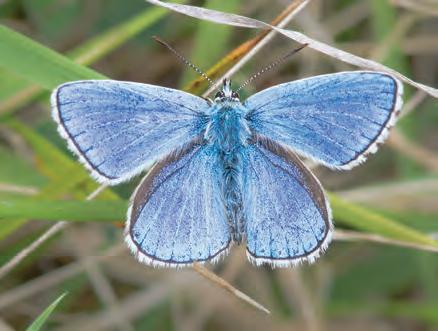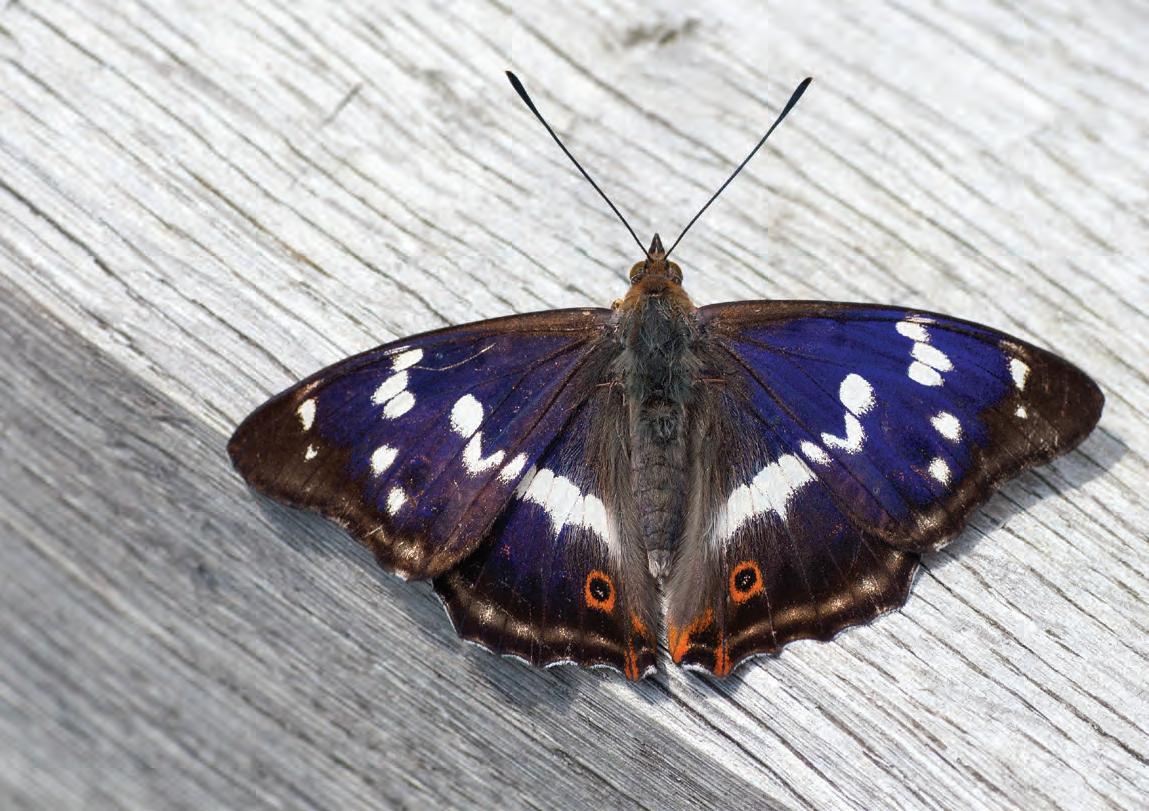
4 minute read
A Life in Flight
A LIFE OF FLIGHT
Adonis Blue (Polyommatus bellargus)

It was the first real day of spring and cherry blossom was bursting from the branch as I saw a flash of colour dip behind sunlit white flowers. It was a Peacock butterfly, common across the UK but still uncommonly beautiful. Some survive for eleven months, hibernating over winter to emerge in March on sunny days. They begin breeding immediately and the next generation arrive in July to gorge en masse on their favourite plant, Buddleia
Walk on the South Downs in early summer and you’re likely to see the dazzling Adonis Blue. The males sport a wing colour to rival those of a kingfisher. A chalk downland specialist, its larvae feed solely on Horseshoe Vetch and the We have as many species of butterflies in Sussex as there are weeks in the year and the majority live out their entire life cycle within our county. Ruth Lawrence reveals which species are most likely to be encountered and some others whose rarity makes their sighting an unusual treat

and summer species are emerging is something of a myth. Although there’s a decline in numbers of spring species in June, the summer species are emerging but will not reach their peak until later. But overall, true butterfly diversity is possibly greatest in June. One of the greatest success stories in Sussex concerns the Duke of Burgundy, the unlikely name of an orange and brown chequered butterfly that used to be prolific in the coppiced woodland of days gone by. Once commercial coppicing almost ceased, the Wealden colonies were lost, one by one. In 2003 just eight individuals were recorded, and the species was heading for adults require short, extinction in Sussex until a man called well grazed turf to survive. Neil Hulme They live in close-knit colonies launched a and rarely wander, residing conservation there their entire lives initiative which in concentrated pulled the species areas and back from the brink. communities. Now, over a thousand Easily may be counted across confused the county, the only with the European member of a slightly paler Chalk tropical family of butterflies Hill Blue, the life cycle of the two species overlap for just a few weeks. As the Adonis Blue Purple Emperor (Apatura iris) called ‘metal marks.’ Another species that has been struggling here is the White-letter disappear in late June, the Hairstreak, with a distinctive ‘W’ Chalk Hill Blue begin to emerge, usually on the underside of its wing. As the peaking in early August. As they begin caterpillars feed solely on Elm, Dutch to die off, the second brood of Adonis Elm disease had a huge impact on this Blue emerges. butterfly. Crispin Holloway, a Life
The ‘June Gap’ when spring Sciences technician at the University butterflies are coming to an end of Sussex managed to save the eggs on a disease-stricken Elm before it was felled on his campus so they could be reared in captivity and transferred to a healthy tree, helping to save the local
Butterfly diversity is possibly greatest in June
Peacock (Aglais io)
Brimstone (Gonepteryx rhamni)

population of this rare butterfly. One of only five Hairstreak species across the UK, it is exceptionally rare to see one. Fortunately, the Brighton and Hove area contains the largest stock of Elms in Britain because of the measures to limit the growth of the Elm Bark Beetle population by East Sussex County Council.
A pioneering rewilding project near Horsham is both the county and UK hotspot when it comes to seeing the magnificent Purple Emperor butterfly. The male sports the rich purple wings which in dull light can appear black. The UK’s largest woodland butterfly, it glides for long distances, sustaining flight with short flicks of the wings and usually emerges in the last week of June with a flight season that only lasts until early August.
The distinctive Yellow Brimstone butterfly can be seen on any warm day, concentrating The Duke of in two peaks; Burgundy Initially in (Hamearis early Spring, in lucina) woodland rides and hedgerows and latterly in high summer to feed on nectar in gardens, in preparation for One of the greatest success stories in Sussex concerns the Duke of Burgundy

Chalk Hill Blue (Lysandra coridon) hibernation over winter. It’s one of only five butterflies that hibernate in winged form, the rest spend winter as caterpillars. If you find one dormant in a shed or building over winter, do not disturb it as the energy it will have to expend in flying may mean it cannot survive for long.
Local butterfly conservation groups are a great place to find further information about butterflies and how to identify them. See how many species you can spot this summer as the warmer weather initiates the arrival of their distinctive colours across Sussex. l www.sussex-butterflies.org.uk


No.37 of Heathfield is an independent womens wear boutique in Heathfield High Street, offering a range of quality clothing, scarves & accessories.











